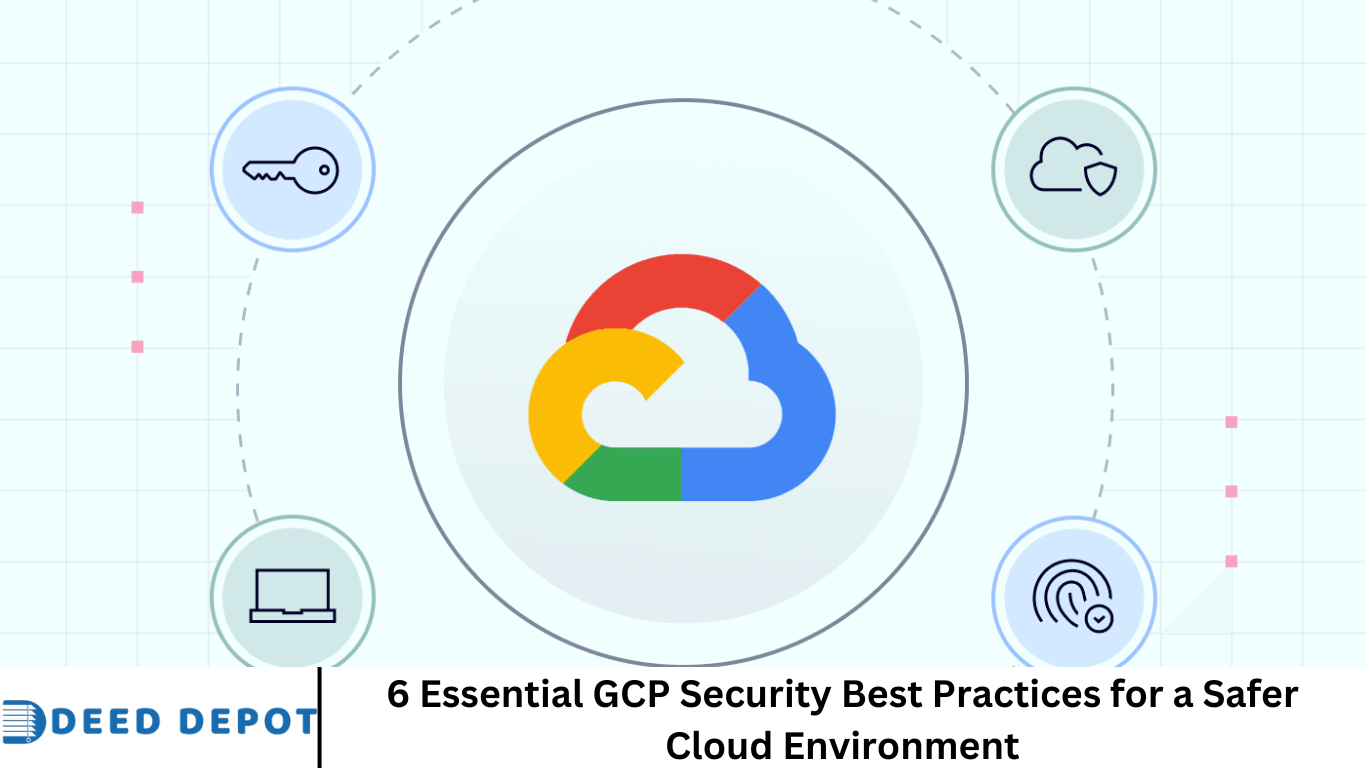Google Cloud Platform (GCP) underpins mission-critical systems for global enterprises. However, this prominence also makes it a prime target for cyber attacks. To protect sensitive workloads and data—and build customer trust—organizations must adopt a proactive, layered security strategy.
This comprehensive guide outlines six essential GCP security best practices to implement from day one, helping DevOps and security teams build a safer, smarter cloud environment.
More Read: Cloud Storage Explained: Definition, Types, Benefits & Best Practices
1. Identity & Access Management (IA): Implement Least‑Privilege & Strong Authentication 🔐
Why IAM matters: Unauthorized access is a primary breach vector in the cloud. GCP IAM enables fine-grained control over who can access what and perform which operations.
Key actions:
- Least-privilege principle: Grant only minimal rights—use pre‑defined IAM roles (Viewer, Editor, Compute Admin) instead of broad Owner or Editor roles.
- Avoid primitive roles: Limit use of Owner/Editor, favor granular roles or custom roles for precise permission scopes.
- Use IAM Recommender: GCP’s IAM Recommender automatically suggests reducing over‑permissioned roles.
- Enforce multi‑factor authentication (MFA): Enable 2FA or hardware-backed keys for all users—critical for protecting privileged accounts.
- Service account hygiene: Don’t use long‑lived keys—rotate them regularly or use workload identity federation instead.
- Audit access policies: Use Cloud Audit Logs and Access Transparency to track IAM policy changes.
Outcome: Precise, well‑audited access controls reduce the risk of compromised credentials causing widespread damage.
2. Secure Data: Encryption at Rest, in Transit & Key Management
Data protection is a fundamental pillar of GCP security.
Encryption at rest:
- GCP encrypts all data by default using AES‑256. For extra control, use Customer‑Managed Encryption Keys (CMEK) via Cloud KMS.
- Consider Customer‑Supplied Encryption Keys (CSEK) when you require full key ownership.
Encryption in transit:
- GCP ensures TLS‑encrypted traffic within infrastructure. For client-server communication, enforce TLS 1.2+ and HTTPS.
- Internally, GCP uses Application Layer Transport Security (ALTS), providing mutual authentication and perfect forward secrecy for RPCs.
Key and secrets management:
- Use Cloud KMS for key lifecycle management, including rotation and IAM-backed access .
- Store secrets in Secret Manager, avoiding secret embedding in code.
Why it matters: Strong encryption and secure key management protect data from unauthorized access and meet compliance standards like HIPAA, GDPR, PCI‑DSS.
3. Network Security & Perimeter Controls
A robust network security posture is essential to prevent unauthorized access and lateral movement.
Best practices:
- VPC design & segmentation: Use separate VPCs or Shared VPCs, with hub-and-spoke design, hubging sensitive workloads away from public-facing services.
- Firewall best practices: Apply restrictive ingress/egress rules, tag-based targeting, and deny-by-default policies .
- VPN & Interconnect: Use Cloud VPN or Dedicated Interconnect for secure connectivity to on-prem networks.
- Private service access: Prefer private IP and private Google access for sensitive VMs.
- VPC Flow Logs: Enable flow logging to monitor suspicious traffic and support for incident analysis.
- VPC Service Controls: Create security perimeters around sensitive data (e.g. Cloud Storage, BigQuery) to block exfiltration.
- Cloud Armor for DDoS: Use Cloud Armor to protect HTTP(S) endpoints against volumetric and application-level attacks.
Benefit: A layered network approach minimizes attack surfaces, limits impact of misconfigurations, and enhances defense.
4. Continuous Monitoring, Logging & Threat Detection
Visibility is the foundation of effective security operations.
Key elements:
- Centralized logging: Collect audit, system, network, and application logs using Cloud Logging and export sinks to SIEM, BigQuery, or Cloud Storage .
- Real-time monitoring: Deploy Cloud Monitoring and custom alerts for unusual spikes or configuration changes .
- Security Command Center (SCC): Use SCC to identify misconfigurations, vulnerabilities, and threats across GCP.
- Vulnerability assessment: Implement automated scanning for VMs and container images, with continuous remediation workflows .
- Audit and compliance checks: Apply CIS benchmarks, NIST, PCI, HIPAA templates to evaluate compliance posture.
- Zero‑Trust implementation: Enforce micro-segmentation, mutual TLS, and identity verification over networks (BeyondCorp/IAP).
Value add: Continuous visibility enables rapid detection and response, drastically reducing the impact of security incidents.
5. Secure DevOps: Harden Infrastructure & CI/CD
Securing cloud infrastructure through DevOps practices builds a resilient deployment pipeline.
Recommended practices:
- Infrastructure as Code (IaC): Use Terraform or Deployment Manager to define infrastructure; enforce policy checks via policy-as-code .
- Pipeline security:
- Use Binary Authorization with signed container images.
- Scan images with Container Analysis for CVEs.
- Store secrets securely in Secret Manager, not in plaintext configs.
- Sandbox containers: Use gVisor via GKE Sandbox or Cloud Run for additional isolation.
- Automate remediation: Use Cloud Functions/Run to auto-revert misconfigs (e.g., open firewall rule) .
Outcome: A hardened CI/CD pipeline curbs risk before code reaches production, enforcing standards with minimal manual effort.
6. Backup, Disaster Recovery & Incident Response
Even the best defenses can be breached—it’s vital to prepare for recovery and continuity.
Essential components:
- Automated backups & versioning:
- Snapshot Compute Engine disks regularly.
- Enable versioning and logging on Cloud Storage buckets.
- Schedule automated backups for Cloud SQL instances.
- High-availability design: Use multi-region deployments and auto-scaling to withstand outages .
- Disaster recovery testing: Regular DR drills help validate backup integrity and recovery timeframes .
- Incident response plan:
- Define roles, communication processes, and playbooks.
- Use Cloud Logging and Audit Logs to guide forensics.
- Maintain offsite backup systems and exercise fallback procedures .
- Cyber insurance & planning: Consider insurance but prioritize proactive planning and rapid containment over relying on claims .
Why it’s critical: A sound IR/DR strategy ensures fast and effective recovery, minimizing downtime and impact on business operations.
Summary Table of Best Practices
| Domain | Key GCP Controls |
|---|---|
| IAM | IAM roles, least-privilege, MFA, service account rotation, IAM Recommender, audit |
| Data Security | Rest/transit encryption, CMEK/CSEK, Cloud KMS, Secret Manager, ALTS |
| Network | VPC segmentation, firewall rules, Interconnect/VPN, Flow Logs, VPC Service Controls |
| Monitoring | Cloud Logging/Monitoring, SCC, vulnerability scanning, benchmarks, Zero Trust |
| DevOps | IaC, Binary Authorization, Container Analysis, gVisor sandbox, automated remediation |
| DR/IR | Backups/snapshots, high availability, DR drills, incident response playbooks |
Implementing This in Your Organization
- Assess your current posture: Use SCC, CIS benchmarks, and IAM Recommender to identify gaps.
- Prioritize quick wins: Enable MFA, tighten IAM, enforce default encryption, activate monitoring.
- Modernize build pipelines: Migrate infrastructure definitions to IaC; secure containers and deployments.
- Build detection & automation capabilities: Integrate vulnerability scanning and auto-remediation.
- Plan and test DR/IR: Schedule regular drills, review incident logs, and refine recovery plans.
- Continual improvement: Stay updated on GCP security evolutions; revise policies and retrain teams.
Frequently Asked Question
Conclusion
Securing a GCP environment is an ongoing, multi-layered endeavor. By implementing these six essential practices—strong IAM, encryption, hardened networking, continuous monitoring, DevOps security integration, and disaster readiness—you can greatly reduce risk, support compliance, and ensure resilience. Adopt a proactive, “security-first” culture and leverage Google’s native tools to establish a reliable, secure cloud foundation.


